Lisbon will host the one-legged affair between Atalanta and Paris Saint-Germain in the UEFA Champions League on Wednesday 12th August. This tactical analysis will take a look at how the two teams will face up against each other.
Atalanta, led by Gian Piero Gasperini, recently finished the Serie A season where they finished third in the league and scored 98 goals in the process. They finished the season in a 2-0 loss against Inter Milan where they certainly did not look up the test as they missed out a 2nd place standing in the league table. However, Josip Iličić was missing in this match and it was clear to see Gasperini’s side suffered as a result creatively. Gasperini’s tactics across the season, however, have been unstoppable offensively and they do not concede all too many shots per game, but the ones they do are of high quality. We will discover in this analysis if this will affect the upcoming match in any way.
Paris Saint-Germain, managed by Thomas Tuchel, have been dominant in recent friendly matches, although they are only friendlies. The Ligue 1 season was cut short, and it will be interesting to see if it has a significant impact on their performance. Unfortunately, in their recently friendly affairs, they lost Kylian Mbappé to an ankle injury, and adding insult to injury, Marco Verratti suffered a calf injury in training, and it seems they will miss his services in this tie as well. This analysis will take a deeper dive into how these injuries will affect PSG in this game.
Predicted Lineups
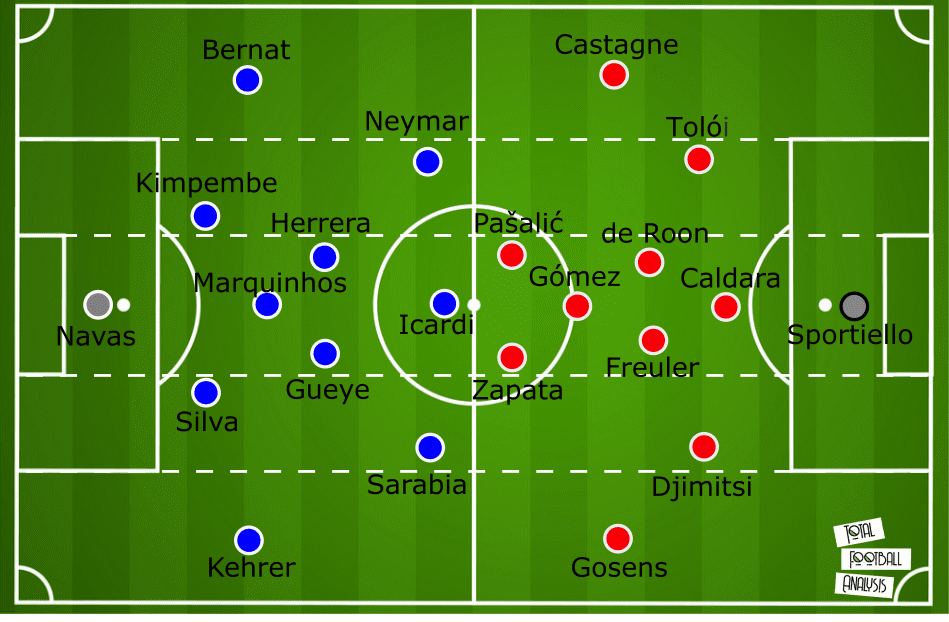
Atalanta (3-4-1-2): Marco Sportiello: Rafael Tolói, Mattia Caldara, Berat Djimsiti: Timothy Castagne, Marten de Roon, Remo Freuler, Robin Gosens: Papu Gómez: Duván Zapata, Mario Pašalić.
Although they rolled out in a 3-4-3 formation in their last match against Inter Milan, they typically prefer to play 3-4-1-2, as to play Gómez in the #10 role, where he has been so crucial to them this term. Gollini suffering a knee ligament tear in their last game against Inter makes for three first-team absentees in this upcoming match-up, adding to José Luis Palomino and Josip Iličić.
As a result, it is a difficult task to predict exactly how they will line-up, but we can assume the back three will stay the same at least, given the lack of options in that area first and foremost. Ruslan Malinovskiy and Luis Muriel, although they have impressed in their minutes this season, the majority of their appearances both come from substitute appearances, and I would anticipate this to continue here. Pašalić has played infrequently as a striker this term when called upon by Gasperini, and I could see him taking up this role here, which could be fruitful, given his strong aerial ability.
PSG (4-3-3): Keylor Navas: Thilo Kehrer, Thiago Silva, Presnel Kimpembe, Juan Bernat: Idrissa Gueye, Marquinhos, Ander Herrera: Pablo Sarabia, Mauro Icardi, Neymar.
Similarly, like Atalanta, PSG are reeling from a number of injuries hampering their first-team options, even with the manager Thomas Tuchel himself suffering a sprained ankle and broken bone in training. Although, in their last Champions League match against Borussia Dortmund, they were missing Marco Verratti and Kylian Mbappé as well, they did adjust accordingly and adjust well they did.
Their second-leg performance was very cohesive and defensively solid, despite missing arguably two of their most important players. They dealt capably with Dortmund’s stellar front-three, with Paredes particularly performing well in dropping back into the defence to form a back five when the midfield became too cluttered. BVB, in that game, lined up 3-4-3, which is similar to what Atalanta could line up in, which bodes well for Les Parisiens chances for this match. Both Veratti and Mbappé have made the matchday squad, but as it seems unlikely either will start the game. Ángel Di María is also suspended for this match, which is also a huge loss for them, given his dynamism in the final third.
Atalanta’s attacking rotations
Tactically, Atalanta can be regarded as Serie A’s most complex side. Their shot volume is high, but this counts for very little if the shots are of poor quality, fortunately, this is not the case for Gasperini’s side. They attack the wide spaces, generating overloads via their attacking rotations, which we will be doing an analysis of here.
Although they attack the least down the centre of the pitch, Gómez is essential in their final-third activity, with Gasperini giving him free-roam to go from side to side, creating chances with aplomb. While they overload the wide areas (typically 4v4s), the Argentinian stays central, and crucially, in space, to receive a pass and force play down one flank via overloads (see below). Their elite attacking talent, like Gómez and Iličić, add a degree of spontaneity and improvisation which most defences just simply cannot handle.
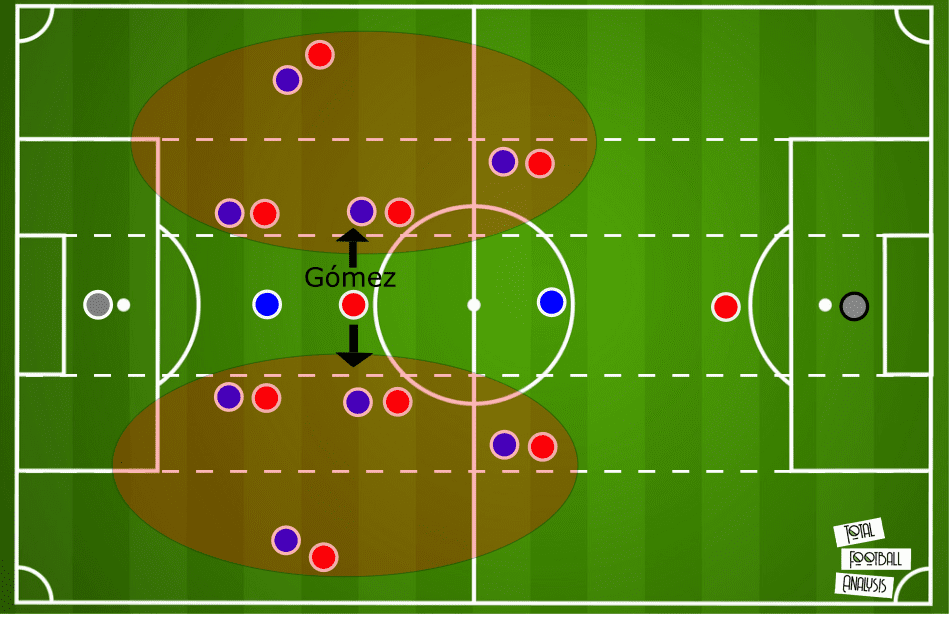
Naturally, the creative players have gained all the plaudits in this team, but their attacking endeavours only occur due to the steady foundation which functions so well due to their hard-working, tactically intelligent midfielders. These two players, whether it be, de Roon, Pašalić, or Freuler, are key in the transition for Atalanta, as they shift their positioning in relation to the movements of the wing-backs and forwards, to guarantee that there is always a passing option available.
If, for example, the wide centre-back carries the ball forward and helps progress the team up the pitch, one of these central-midfielders may drop back, and allow the side to maintain their defensive shape by plugging the gap. If the centre-backs stay in place, the central-midfielders will push up and wider, especially Pašalić, who often likes to go beyond even the centre-forward (see an example below). When this is in full motion, this ends up with Atalanta being in a 3-2-5 formation, which demands a lot of the two midfielders, depending on what else is happening on the pitch.
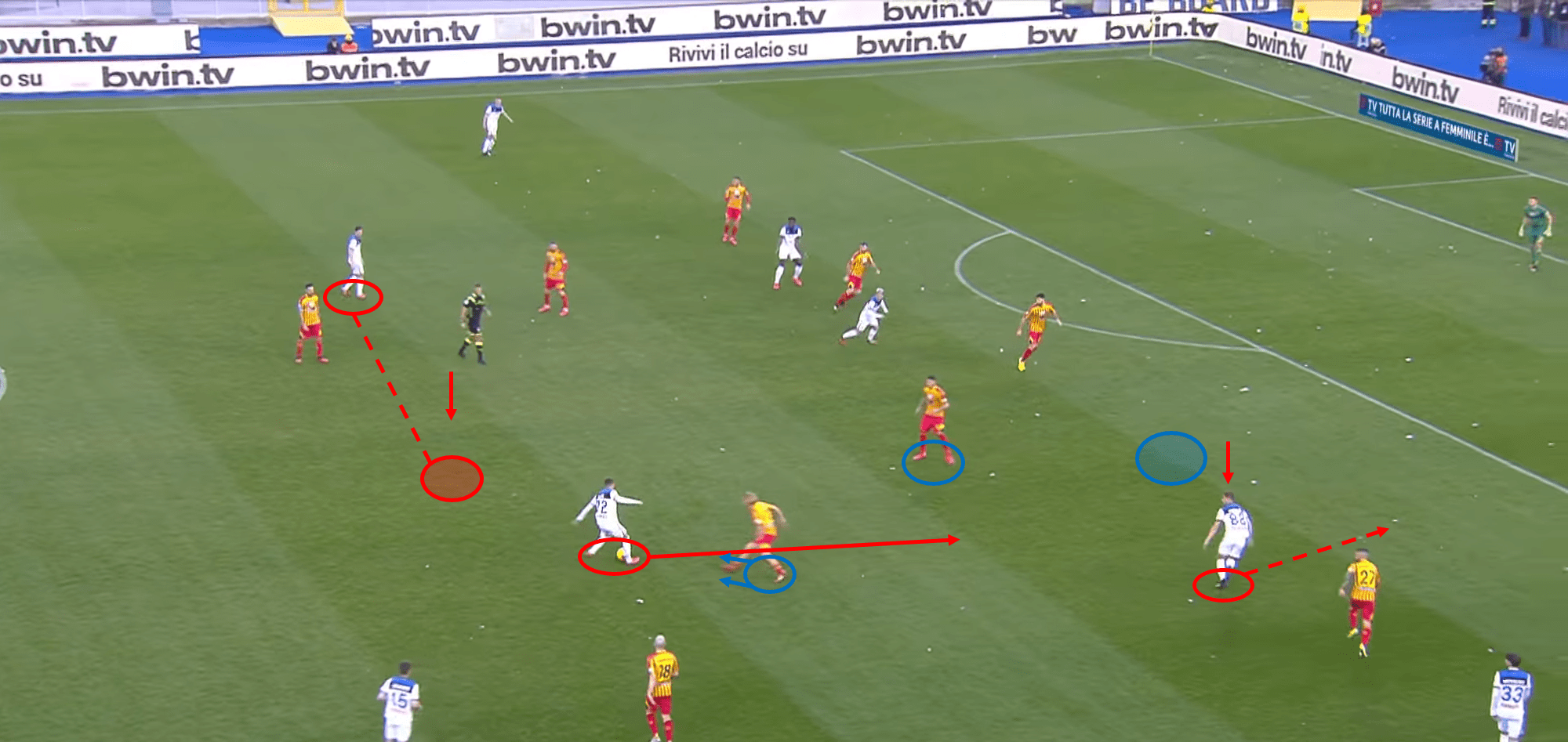
Notice the above analysis where Pašalić (#88) is usually positioned, next to his midfield compatriot. Iličić has dropped deep to receive the ball, dragging a couple of defenders out of position to leave space for Pašalić to run into. This leads to the Croatian getting in behind the Lecce defence, and delivering a cut-back for a forward to score from.
When attacking, the wing-backs typically stay wide but will cut inside and offer an option in the half-space, especially if one of the forwards carries the ball out wide. The three central defenders will also carry this desire to overloads the wide and half-spaces.
They will carry the ball forwards or make runs into attacking positions, which as mentioned, will be covered by one of the two midfielders. Supplementing this, their defensive shape is very wide, which allows their back three to support and create overloads down the wings more easily. This stretches the opposition defence and creates gaps elsewhere for Atalanta players to exploit, either through creating space for a pass into dangerous positions or from runs that penetrate into the opposition box.
All these rotations and overloads provide the space for the front two and Gómez, who interestingly, uses the referee as a point of reference as to where to position himself and stitch play together from there. The two forwards will roam to a certain extent, but they spend a good portion of their time in the wide channels, creating space for runs from deep (see below). Throughout all this, the three attacking players will drive forwards, utilising quick one-twos and will switch the angle of attack from the half-space into the centre swiftly.
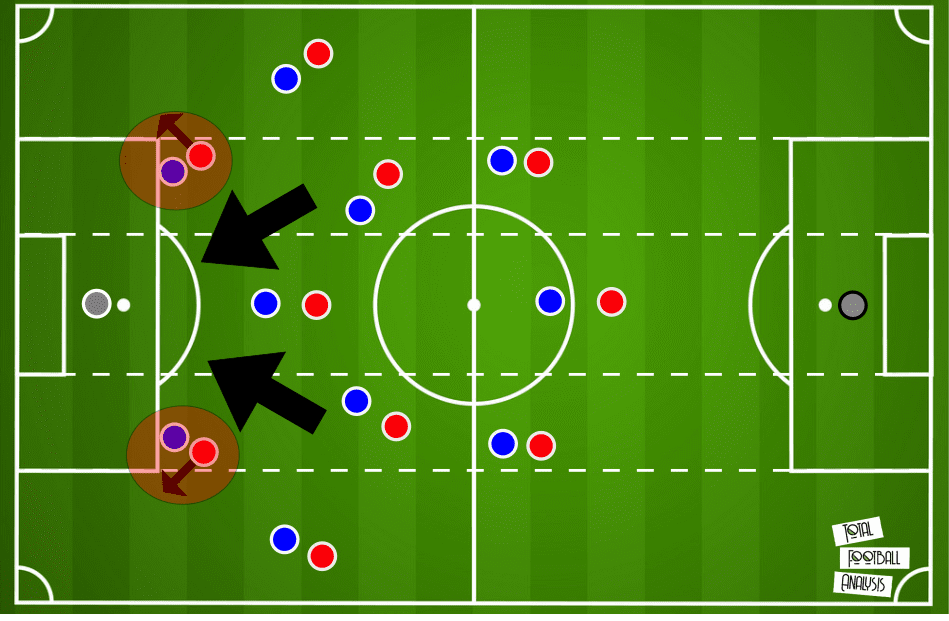
PSG’s transformation into a 4-2-2-2 or 4-3-3
PSG have begun a large portion of their games this season in an orthodox 4-4-2, but as they begin to dominate proceedings, in terms of possession, their wide men (Neymar and Di María) push up and into the half-space to enable supremacy in the final third. The two centre-forwards pin the centre-backs back towards their own goal-line, while the two wide players will find space between the lines in dangerous zones, which was the theme of the entire first-half in their second-leg tie against Dortmund.
Dortmund’s plan in that game was to use their 5-4-1 formation in defence to their advantage, boxing in the two central midfielders with their five players who were up the pitch and force them into wide areas. Neymar and Di María would position themselves beyond the midfield line, which made it easy for Tuchel’s side to progress the ball from deep (see displayed below). Although it should be noted that in this game against Dortmund, die Schwarzgelben were far too static defensively, which led to plenty of space available for Les Parisiens’ forwards to exploit. This is likely to not be the case against Atalanta, who are flexible in their defensive positioning.
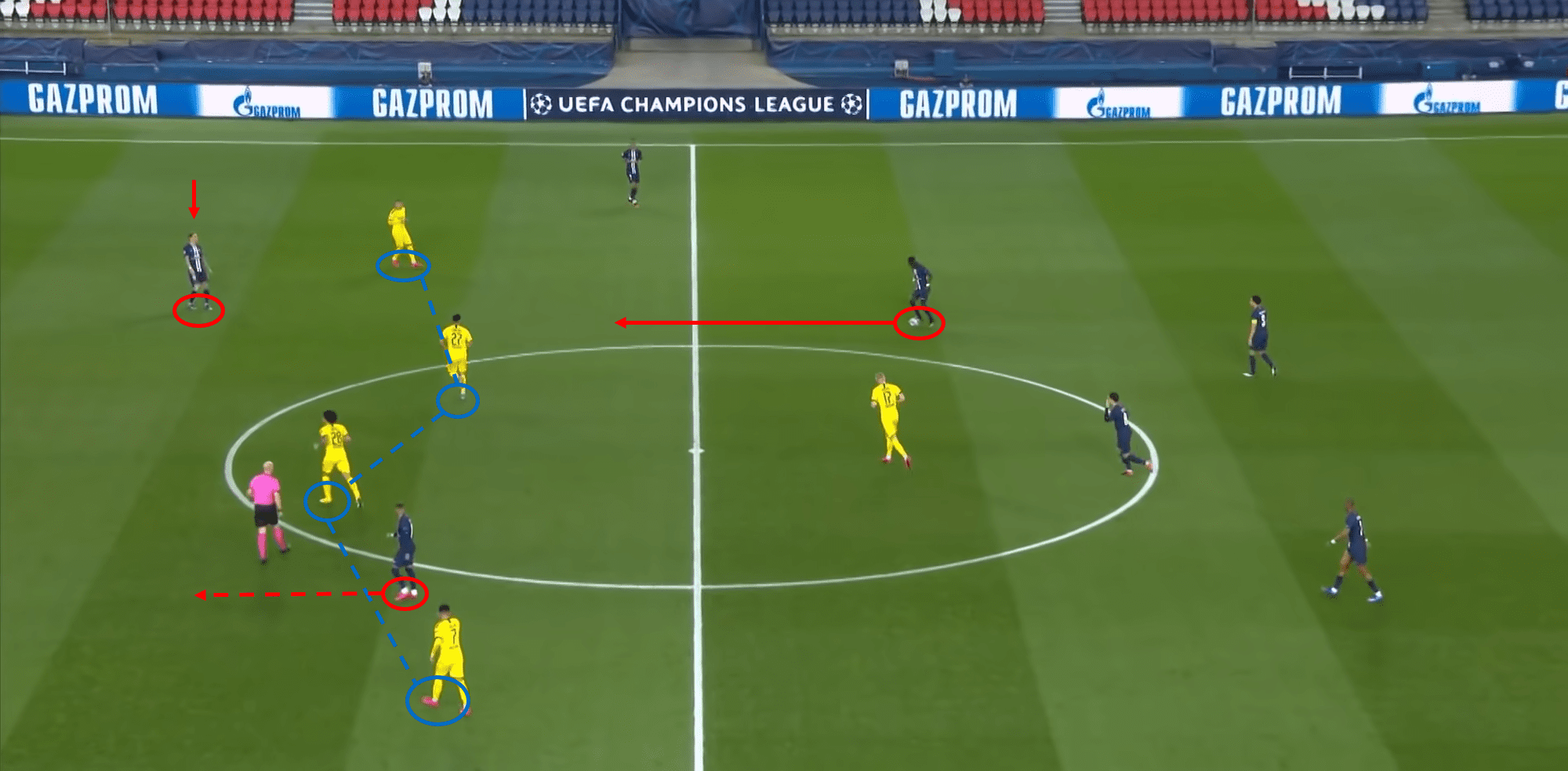
Above we can see Di María positioned beyond the Dortmund midfield, calling for the ball. Gueye has the time and space to pick him out with a direct pass. Down the left flank, Neymar is keeping an eye on the play and is ready to make a run towards the final-third to provide numerical dominance in the final-third.
As stated earlier, in this game, Paredes would drop deep to get onto the ball without the pressure of the Dortmund midfielders, and progress the ball towards the flanks, where Tuchel’s men found it easy to progress the ball up the pitch. At the same time, PSG would form into a 4-4-2 when they were not pressing the opposition, but as the opposition full-backs would come back to provide a passing option, this would switch to a 4-3-3 formation, where PSG’s forward would then press far more aggressively.
When attacking, Dortmund would attempt to manipulate the PSG defence by bringing a defender out of position, allowing another attacker to exploit the space left in behind, which was Erling Braut Håland attempted in that game. However, Tuchel’s side dealt well with the young Norwegian by ensuring they had two men in his zone of play for the majority of the match, meaning it was nearly impossible to find the 20-year-old with a direct pass (as seen below).
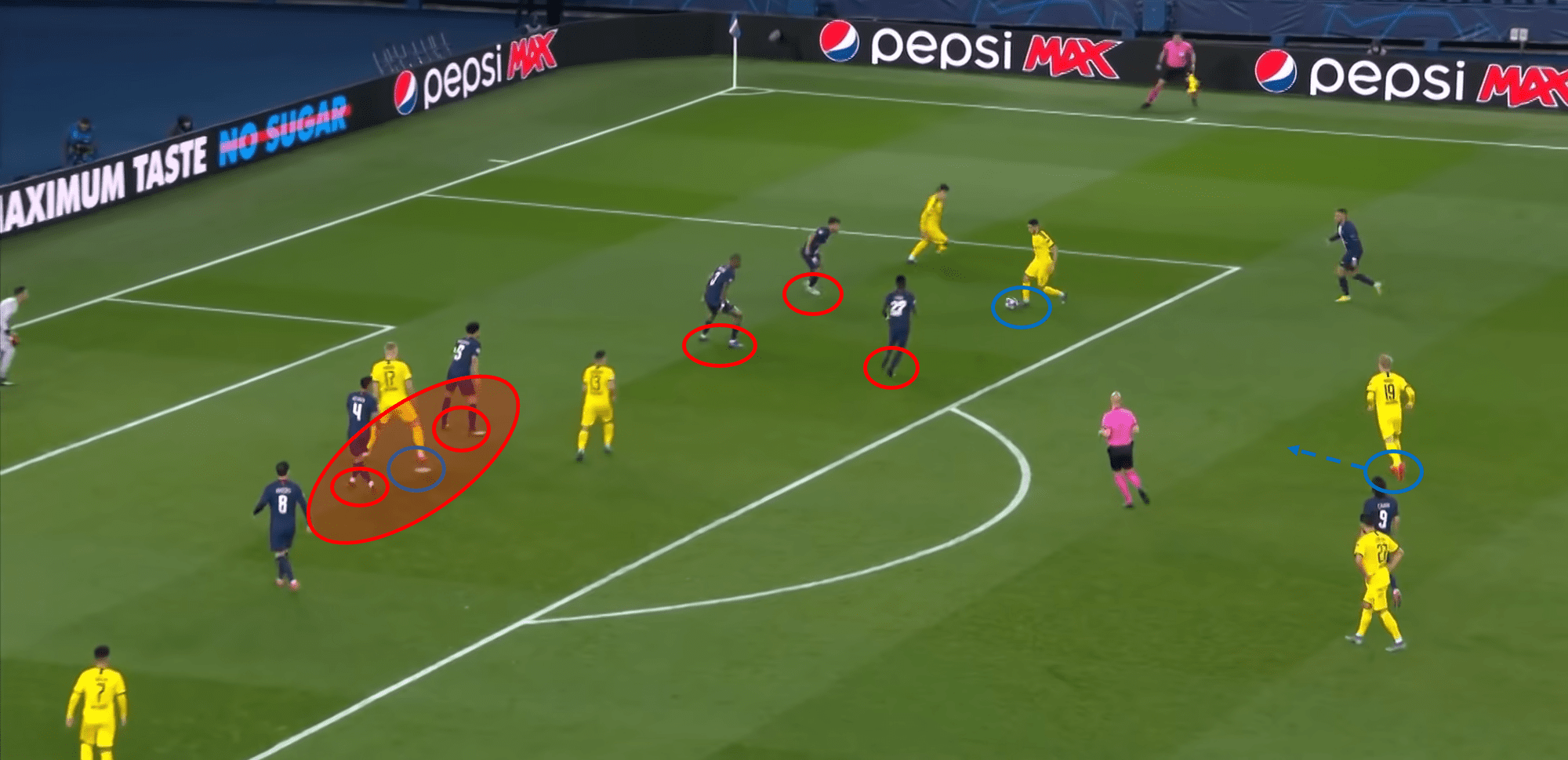
Overhead in the analysis, we can see how Håland was contained by PSG, and this is something they could execute on Zapata. By blocking off a possible sprint with Kehrer behind him, and Marquinhos in front to stop any possible aerial danger.
In a 4-3-3 formation, PSG’s forwards drop off regularly, entering the wide zones or the half-space, while the full-backs tend to overlap (see beneath for how this might pan out). The aim of this being to overload the midfield while simultaneously disrupting attempts to mark the forwards and create space to run into. Their midfield set-up is staggered with one defensive midfielder typically staying back to provide defensive cover, while another midfielder will also drop back to act as a second deep distributor of the ball.
The third midfielder pushes up higher, to provide an attacking option to outnumber the opposition on one side of the pitch. Additionally, this overloading of one side of the pitch is exploited by quick switches to the other flank, which is in sync with their pressing, which will press one side of the pitch, and then once they have regained the ball, look to immediately switch play to the other side of the pitch.
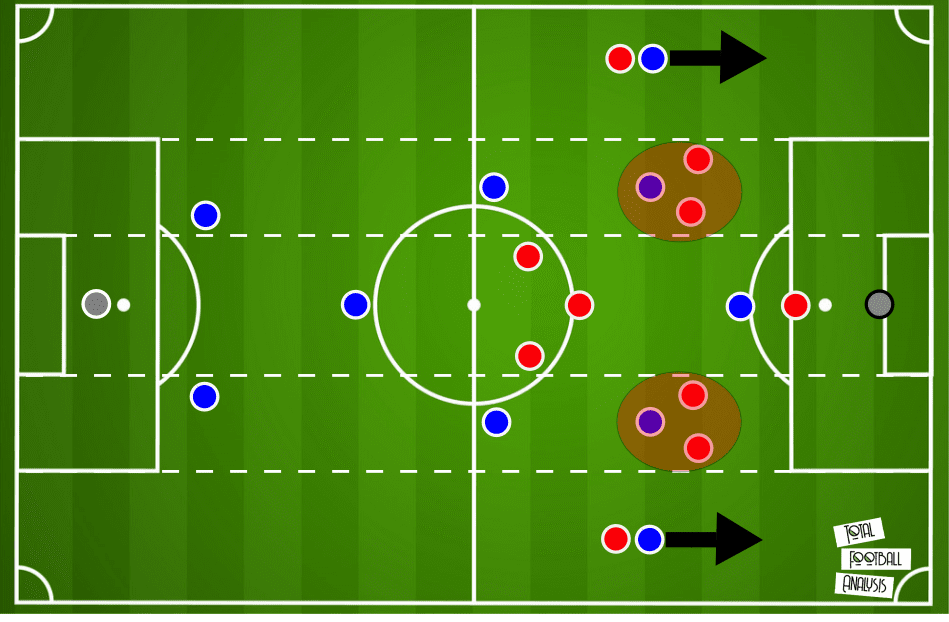
Although this is their typical tactical approach while utilising the 4-3-3, Tuchel is flexible and adaptive with his set-ups, often altering formations and line-ups to counteract the key threats of an opposition. This is something he has been forced to do throughout his time at PSG, with injuries to key players such as Neymar, Verratti, or Rabiot once upon a time. For example, they have used the previously mentioned 4-4-2 formation to a great degree of success in these times. Though this is not a case of experimenting with different systems, more-so Tuchel is trying to exploit the weaknesses of his opposition, which has been one of his biggest achievements to date in the French capital.
PSG’s weakness in their defence can sometimes become apparent when a side can press just as well as they do, in these cases succumbing to that pressure and losing possession of the ball. Additionally, when the defence forms into a 3 at the back in-game, the central defenders can be dragged out of position quite easily, and as such quality chances can be created.
Final Predictions
What does all of this mean for the upcoming UCL tie? Well, in arguably Neymar’s most important game of his career, attempting to prove his price tag was worth it to the footballing world, he is without some of his best teammates from the get-go. The 28-year-old is approaching the peak of his career and certainly has the talent to drag his side to a victory in this game, but it is more of a question of his determination to display this quality.
As a 4-3-3, PSG will look to dominate proceedings in midfield, by ensuring that two midfielders will come back as options to progress the ball forwards from deep. In this case, one would imagine that Tuchel’s men will outnumber Atalanta in the midfield and that this midfield battle, at least on a possession basis, will be won by Les Parsiens. Atalanta’s system demands a lot of the two central midfielders, and it might be the case that dealing with PSG’s talent will be all too much for them, suffering from being bypassed due to the overloads created by PSG.
Although, it is likely that Herrera will be starting as the left central-midfielder in this game, and he does not boast the highest amount of progressive distance per game, as this is not his strong suit, despite it being likely that this will be his task in this upcoming tie. Atalanta can exploit this by deploying a more aggressive press upon Herrera, perhaps using their two midfielders and Gómez to box in the Spaniard, regaining possession of the ball, and getting the ball back towards the wide areas and complete their attacking rotations from there. It should be noted that Mbappé could be fit enough to make an appearance off the bench, and this could also be enough to change the tide of the game, using his electric pace against Atalanta’s tired legs in the last ten to fifteen minutes.
In a 3-4-1-2, it would be wise to encourage Castagne to stay back on a more regular basis, as to help Tolói deal with Neymar, who is PSG’s biggest threat going forward creatively. Icardi is not a striker to create a chance out of nothing; thus, if you cut off his creative supply, he will not have the chance to improve upon his six goals in his last five games against Atalanta.
When Gasperini’s side attack, they should be focusing their efforts down their left wide space, encouraging Gosens to push up and make runs in behind, with Gómez, Djimsiti, and Freuler looking to find the German with a through ball. Gosens would then be faced up against Kehrer, who is a solid defender, but if they complete one of their previously mentioned one-twos, the young German can be bypassed. Gosens can then get into the position to complete a cut-back into one of the two forwards, which we have seen happen regularly this season, to great success.
Gómez is the type of player who can create a chance out of his individual quality and nothing else, he stands out as a triple threat in the final third, he can finish, he can create high-quality chances, and he can also take on his man. All of this added up will make him a very difficult man to handle in a game of this stature.
VAR can change the result of any game, depending on what the refereeing team decide to give on the day. So, this makes it hard to predict an exact result. Nevertheless, my final prediction would be a 3-2 victory for PSG.


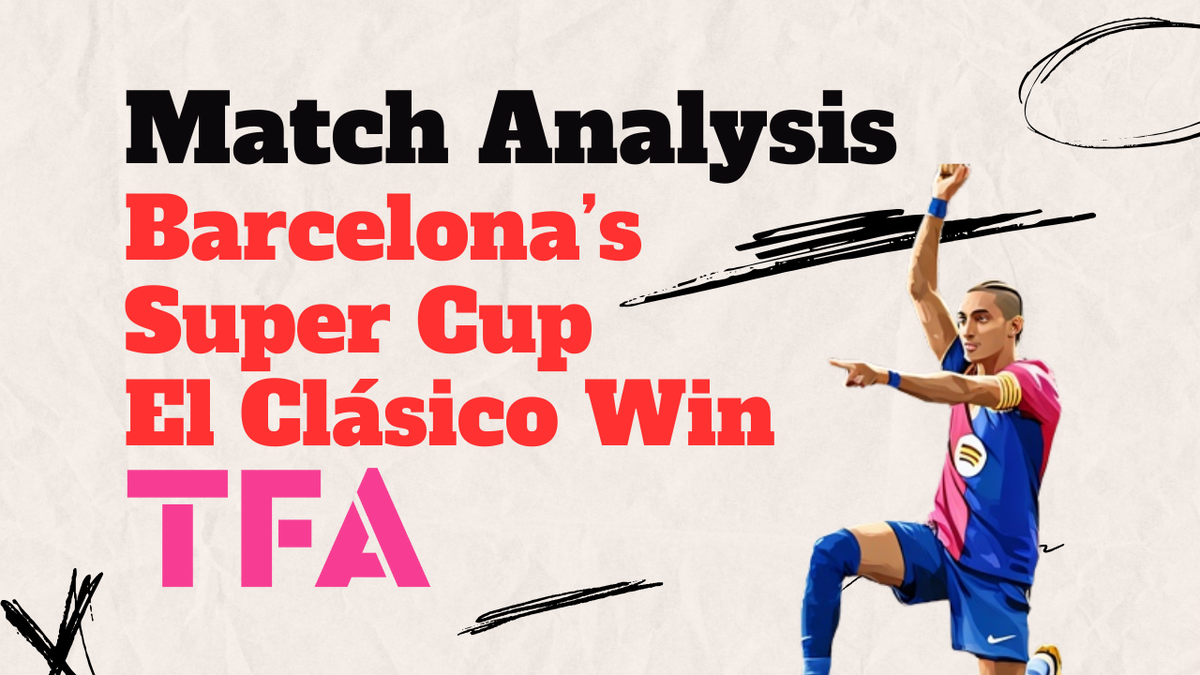
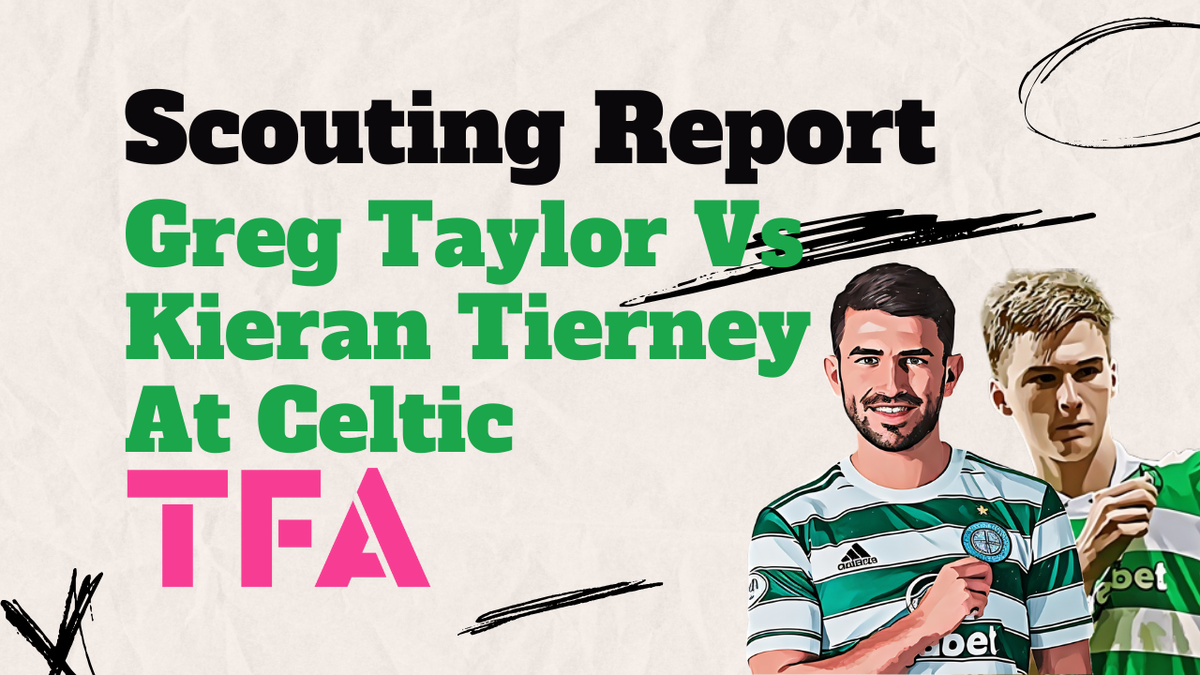
Comments